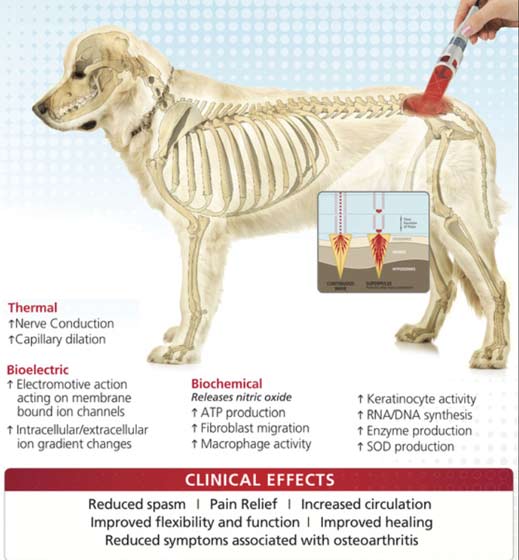Choosing Between Laser Therapy vs. Red Light Therapy Dogs: Which Is Better?
How Red Light Therapy Can Improve Your Dog's Overall Health
Red Light Therapy has become an encouraging alternative for boosting canine health and wellness. This non-invasive treatment promotes cellular activity and advertises recovery in pets experiencing different disorders. Numerous pet proprietors report noticeable benefits, including pain relief and boosted flexibility. Nonetheless, comprehending the potential applications and hidden systems is important. What specific problems can it resolve, and exactly how can it be securely integrated into a pet's treatment routines? The solutions might stun you.
Recognizing Red Light Therapy: What It Is and Exactly how It Functions
Although red light therapy has gotten popularity in human medication, its application for dogs is progressively recognized for its potential benefits. This non-invasive treatment makes use of particular wavelengths of light, generally in the red and near-infrared range, to stimulate cellular function. The underlying concept involves the absorption of light by mitochondria, which increases ATP manufacturing and boosts cellular metabolic rate.
Therefore, red light therapy advertises boosted blood circulation and help in cells fixing. The therapy is provided with tools such as lasers or LED panels, which can be directed at particular areas of a dog's body. Therapy sessions are typically brief, making it a convenient choice for pet owners.
Recognizing this technology's mechanisms can aid caregivers make informed decisions regarding their dog's health care. As research study remains to evolve, the interest in red light therapy as a complementary treatment method for various canine problems is likely to expand.

Benefits of Red Light Therapy for Dogs
Red light therapy supplies several considerable advantages for pet dogs, consisting of reliable discomfort alleviation and a sped up recovery process. This therapy can improve flexibility and adaptability, making it especially useful for maturing or wounded pets. As even more pet dog owners look for alternate therapies, understanding these benefits becomes increasingly vital.
Discomfort Relief Applications
Lots of canine proprietors are turning to red light therapy as an encouraging solution for minimizing pain in their pets. This non-invasive treatment uses specific wavelengths of light to penetrate the skin, boosting mobile task and decreasing inflammation. Pet dogs struggling with chronic conditions such as arthritis, hip dysplasia, or post-surgical pain might experience substantial relief with this therapy. Studies indicate that red light therapy can improve blood flow, aiding to provide necessary nutrients to impacted areas, better adding to discomfort reduction. Furthermore, it may aid to lower the dependence on pharmaceutical painkiller, which commonly feature unfavorable negative effects. Therefore, many veterinarians are progressively suggesting red light therapy as a risk-free and reliable option for handling discomfort in pets.

Accelerated Healing Process
The advantages of red light therapy prolong past discomfort relief, playing a crucial duty in increasing the recovery procedure for pet dogs. This innovative therapy advertises mobile regrowth, boosting the manufacturing of ATP, which improves power schedule for recovery tissues. Additionally, red light therapy boosts blood circulation, causing improved oxygen and nutrient distribution to hurt areas. This enhanced circulation not just aids in faster recovery yet likewise decreases inflammation, a typical barrier to healing. On top of that, the therapy urges collagen manufacturing, vital for cells fixing and regrowth. Generally, by assisting in these biological processes, red light therapy considerably shortens recuperation times, allowing dogs to return to their regular activities faster and with higher vitality.
Improved Wheelchair and Flexibility
Improved wheelchair and versatility are considerable advantages of red light therapy for dogs, specifically for those dealing with joint pain or tightness. This non-invasive treatment uses specific wavelengths of light to permeate tissues, advertising increased flow and reducing swelling. Therefore, pet dogs typically experience remedy for discomfort related to arthritis, hip dysplasia, or post-surgical healing. Routine sessions can boost mobile repair and improve muscular tissue function, allowing dogs to restore their all-natural series of movement. Owners have actually reported obvious enhancements in their family pets' ability to run, jump, and participate in activities they once delighted in (Red Light Therapy Dogs). Ultimately, red light therapy not only helps reduce pain however likewise adds to a much more active and satisfying way of life for pet dogs, improving their overall high quality of life
Problems That Can Be Cured With Red Light Therapy
Although red light therapy has actually gained appeal in different areas, its application in veterinary care, particularly for canines, has revealed guarantee in dealing with a series of conditions. This non-invasive treatment method is thought to aid in alleviating discomfort and inflammation connected with arthritis, aiding older pet dogs gain back flexibility. In addition, it has actually been made use of to help in the recovery of wounds, burns, and surgical incisions, advertising faster recuperation times.
Skin conditions, such as dermatitis and hot spots, may also respond positively to red light therapy, reducing inflammation and motivating much healthier fur development. Additionally, the therapy can be useful for canines enduring from conditions like hip dysplasia, tendon injuries, and muscular tissue pressures. By promoting cellular repair and boosting flow, red light therapy provides an all natural strategy to enhancing the general wellness of dogs, providing alleviation and advertising a much better lifestyle.
The Scientific Research Behind Red Light Therapy
Red light therapy runs on the concept of photobiomodulation, which includes check it out the application of particular wavelengths of light to boost cellular procedures. These wavelengths, generally ranging from 600 to 1000 nanometers, permeate the skin and are taken in by mitochondria, the energy-producing elements of cells. This absorption enhances ATP production, bring about enhanced energy schedule for mobile functions.

Research studies suggest that red light therapy might also modulate immune feedbacks and assistance general cellular health. By using these organic mechanisms, red light therapy provides a non-invasive treatment option that can add significantly to a dog's health and healing from various problems.
Exactly How to Incorporate Red Light Therapy Into Your Dog's Regular
Integrating red light therapy into a pet dog's routine can be an uncomplicated process, gave that family pet owners approach it with treatment and consistency. Choosing an ideal gadget is basic, as choices array from handheld devices to larger panels (Red Light Therapy Dogs). Owners ought to start by presenting the therapy slowly, enabling their pets to adjust to the light direct exposure. Procedure can be arranged for around 10 to 20 mins, ideally a couple of times a week, depending upon the pet's requirements and the advice of a veterinarian
Establishing a comfortable atmosphere is essential; utilizing a silent room where the canine feels loosened up can enhance the experience. Throughout the sessions, proprietors can engage their pets with calming voices or mild stroking to develop a calming ambience. Monitoring the dog's action is critical to guarantee the therapy is useful and delightful, ultimately aiding to enhance their general well-being.
Security Considerations and Precautions for Red Light Therapy
When taking into consideration red light therapy for canines, safety and security needs to always be a top priority to assure a favorable experience. Family pet owners should speak with a veterinarian before beginning any kind of therapy, specifically for pets with pre-existing problems or those taking drugs. It is vital to pick tools especially developed for animals, as human devices might not appropriate.
Proper eye protection is essential; both the canine and the trainer ought to wear goggles to protect their eyes from potential injury. Furthermore, sessions should click for source be checked carefully to avoid too much exposure. It is recommended to begin with much shorter sessions and slowly raise period based on the pet dog's reaction.
Proprietors must also observe their pet dogs for any type of indicators of discomfort or adverse responses during and after therapy. By following these safety and security considerations, red light therapy can be a valuable and risk-free choice for boosting a pet dog's well-being.
Regularly Asked Concerns
Just how Usually Should I Make Use Of Red Light Therapy on My Dog?

Can Red Light Therapy Change Typical Vet Therapies?
Red light therapy must not change typical veterinary treatments. While it may complement therapies by promoting healing and reducing discomfort, consulting a vet continues to be crucial for thorough treatment and resolving hidden wellness problems in pet dogs.
Are There Any Negative Effects of Red Light Therapy for Dogs?
Red light therapy for dogs usually has marginal side impacts, such as temporary skin inflammation or heat at the treatment site. A lot of dogs tolerate the therapy well, yet checking for any type of uncommon reactions is suggested.
What Is the Suitable Duration for Each Red Light Therapy Session?
The suitable duration for each red light therapy session normally ranges from 10 to 20 minutes, relying on the pet dog's certain requirements and problem. Consultation with a vet is suggested to tailor the treatment suitably.
Is Red Light Therapy Suitable for All Canine Types?
Red light therapy is typically appropriate for most dog types. Private health and wellness conditions and sensitivities might impact its applicability. Consulting a vet guarantees the therapy is risk-free and useful for every specific pet dog.
Lots of canine owners are turning to red light therapy as a promising service for minimizing pain in their pets. Boosted mobility and versatility are considerable advantages of red light therapy for canines, especially for those enduring from joint discomfort or rigidity. Red light therapy runs on the concept of photobiomodulation, which involves the application of particular wavelengths of light to boost mobile processes. Research suggests that red light therapy can promote recovery, reduce inflammation, and relieve pain in canines. Red light therapy for dogs typically has very little side impacts, such as short-term skin soreness or heat at the therapy website.